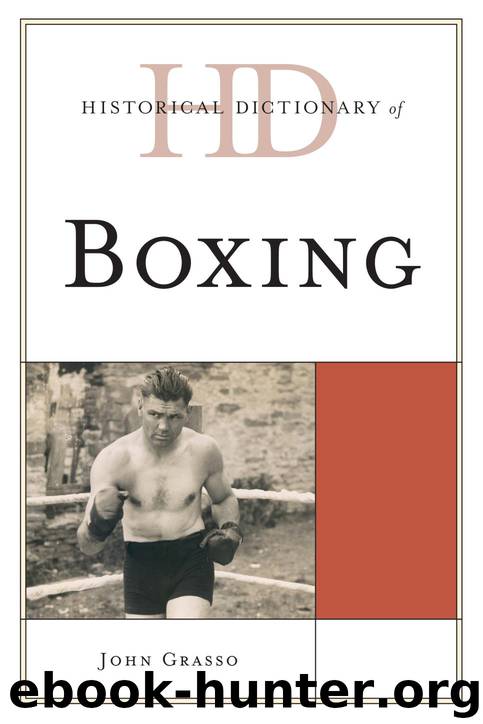Historical Dictionary of Boxing by Grasso John

Author:Grasso, John.
Language: eng
Format: epub
Tags: undefined
Publisher: Scarecrow Press Inc.
Published: 2012-12-27T16:00:00+00:00
LOUIS–SCHMELING
From 1934 to 1936, heavyweight Joe Louis won 24 straight bouts, 20 by knockout, and appeared headed for a match for the heavyweight championship. In preparation for a somewhat routine match with former heavyweight champion German Max Schmeling, Louis trained at a resort in Lakewood, New Jersey. There he was introduced to the game of golf, which quickly became almost an obsession to him. Consequently, he was not adequately prepared for his 19 June 1936 bout with Schmeling at Yankee Stadium. Conversely, Schmeling had studied Louis and noticed that Louis would drop his left hand at times after throwing a punch. Although Louis entered the ring as a 10–1 favorite, Schmeling caught Louis in the fourth round and knocked him down. In the 12th round, Schmeling again connected, and Louis was counted out by referee Arthur Donovan at 2:29 of the round in a fight named “Fight of the Year” by Ring magazine.
Louis went on to win the heavyweight title in 1937 but still felt that he needed to avenge his loss. In the two years since their first fight, the Nazi party had gained strength in Germany with their platform of Aryan supremacy. The highly anticipated return match took place on 22 June 1938 and was built up by the promoters as a match between the Nazi Schmeling and the black American Louis, even though Schmeling was not a member of the Nazi Party. Prior to the bout, Louis was encouraged by President Franklin D. Roosevelt, who told Joe, “We need muscles like yours to beat Germany.” The bout drew 70,043 to New York’s Yankee Stadium and was broadcast worldwide. The bout only lasted two minutes and four seconds, as Louis received his revenge. Louis knocked Schmeling down three times, and after the third knockdown, Schmeling’s corner threw in the towel and referee Arthur Donovan looked at the beaten Schmeling and stopped the bout.
The reaction in the United States, especially in the black communities, was one of great joy coupled with relief. As a result of that bout, and Louis’s service to the country during World War II, he became the first truly nationwide African American hero in the United States. Ironically, in later years Schmeling and Louis became good friends, and Schmeling was a pallbearer at the funeral of Louis in 1981.
Download
This site does not store any files on its server. We only index and link to content provided by other sites. Please contact the content providers to delete copyright contents if any and email us, we'll remove relevant links or contents immediately.
A Dictionary of Sociology by Unknown(3023)
The Art of Dramatic Writing: Its Basis in the Creative Interpretation of Human Motives by Egri Lajos(3015)
The Dictionary of Body Language by Joe Navarro(2946)
0041152001443424520 .pdf by Unknown(2784)
How The Mind Works by Steven Pinker(2729)
Day by Elie Wiesel(2717)
Merriam-Webster's Collegiate Thesaurus, Second Edition by Merriam-Webster Inc(2710)
The Meaning of the Library by unknow(2503)
The Official Guide to the TOEFL Test by ETS(2285)
A History of Warfare by John Keegan(2184)
The Emotion Thesaurus: A Writer's Guide to Character Expression by Puglisi Becca & Ackerman Angela(2122)
Emotion Amplifiers by Angela Ackerman & Becca Puglisi(2006)
MASTER LISTS FOR WRITERS: Thesauruses, Plots, Character Traits, Names, and More by Bryn Donovan(1907)
The Cambridge Guide to English Usage by PAM PETERS(1880)
Merriam-Webster's Pocket Dictionary by Merriam-Webster(1880)
Star Wars The Rise of Skywalker The Visual Dictionary by Pablo Hidalgo(1843)
Lucky Jim by Kingsley Amis(1697)
American Accent Training by Ann Cook(1635)
Word by Word by Kory Stamper(1613)
